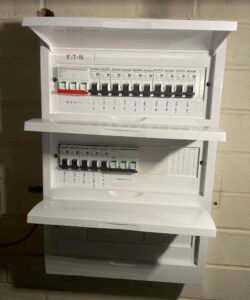An electrical fuse box serves as a central unit that contains and controls fuses safeguarding an electrical system. It acts as a main distribution point where electricity from the utility provider is distributed safely to different circuits across a property.
Now, what was once known as a fuse box is now referred to as a switchboard, equipped with circuit breakers and RCDs instead of traditional fuses.
The electrical fuse box plays a crucial role in maintaining the integrity of a property’s electrical system.
In this blog, we’ll talk about the role of an electrical fuse box and its main parts.
What is the Role of an Electrical Fuse Box?
The role of an electrical fuse box is multifaceted, primarily focusing on the distribution and regulation of electrical power within a building. Its importance in both residential and commercial settings cannot be understated.
Let’s consider its specific functions below:
- Distribution of Power: The fuse box is pivotal in distributing electricity from the main supply to various circuits throughout the premises. It ensures that electricity is efficiently and safely channelled to different areas, be it lighting, heating, or appliances.
- Safety and Protection: One of the most crucial roles of the fuse box is to provide safety. It protects the electrical system from overload or short circuits. This action helps prevent potential fire hazards or damage to electrical appliances.
Moreover, the fuse box acts as a central point for electrical control, making it easier for electricians to manage and maintain the system. It also houses circuit breakers and, in some cases, residual-current devices (RCDs), which provide additional safety measures.
The integration of a switchboard within the fuse box layout offers a streamlined approach to electrical management, enhancing overall system efficiency and safety. The fuse box is a critical component in any electrical installation, ensuring smooth operation and safeguarding against electrical risks.

3 Main Parts of a Fuse Box or Switchboard
The 3 main parts of a fuse box or switchboard are the main switch, switchboard, and circuit breakers:
Main Switch
The main switch is a critical component of a fuse box or switchboard, acting as the control point for the electrical supply. It allows the entire electrical supply to a property to be turned on or off. This is particularly useful during maintenance or in emergency situations, providing a swift means to disconnect power.
Switchboard
The switchboard is the part of the fuse box where individual circuits are managed and distributed. It plays a key role in dividing the main electrical supply into smaller circuits, each supplying power to different parts of the property. It also ensures that electricity is distributed safely and efficiently, reducing the risk of overloading any single circuit.
Circuit Breakers
Circuit Breakers are integral to the safety functions of a fuse box. They are designed to automatically cut off the electrical supply when an overload or fault is detected in a circuit. This helps in preventing potential electrical fires or damage to appliances.
How Will I Know If I Need a New Fuse Box?
You will know if you need a new fuse box when you experience frequent electrical issues, such as circuit breakers tripping or fuses blowing often. These signs indicate that your current system may be outdated or unable to handle your property’s electrical demands.
Additionally, if your fuse box lacks safety features like an RCD, it’s time to consider an upgrade for enhanced protection.
Is a Fuse Box and a Switchboard the Same?
Yes, the term ‘fuse box’ was used when fuses protected electrical systems. Now, we use circuit breakers and RCDs and call them switchboards. Initially, fuse boxes used fuses for protection, but modern switchboards utilize circuit breakers and RCDs.
These components are vital in managing and protecting an area’s electrical system despite their differences in capabilities and technologies.
